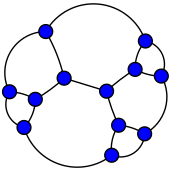Robert Wertheimer Frucht (later known as Roberto Frucht) (9 August 1906 – 26 June 1997) was a German-Chilean mathematician; his research specialty was graph theory and the symmetries of graphs.
Education and career
In 1908, Frucht's family moved from Brünn, Austria-Hungary (now in the Czech Republic), where he was born, to Berlin. Frucht entered the University of Berlin in 1924 with an interest in differential geometry, but switched to group theory under the influence of his doctoral advisor, Issai Schur; he received his Ph.D. in 1931.
Unable to find academic employment in Germany due to his Jewish descent, he became an actuary in Trieste, but left Italy in 1938 because of the racial laws that came into effect at that time. He moved to Argentina, where relatives of his wife lived, and attempted to move from there to the United States, but his employment outside academia prevented him from obtaining the necessary visa. At the same time Robert Breusch, another German mathematician who had been working in Chile for three years but was leaving for the U.S., invited Frucht to fill his position at Federico Santa María Technical University in Valparaiso, Chile, where Frucht found an academic home beginning in 1939.
At Santa María, Frucht became dean of the faculty of mathematics and physics from 1948 to 1968, and retired to become an emeritus professor in 1970.
Contributions

Frucht is known for Frucht's theorem, the result that every group can be realized as the group of symmetries of an undirected graph, and for the Frucht graph, one of the five smallest cubic graphs without any nontrivial symmetries. LCF notation, a method for describing cubic Hamiltonian graphs, was named for the initials of Joshua Lederberg, H. S. M. Coxeter, and Frucht, its key developers.
With Coxeter and David L. Powers, Frucht was coauthor of a book on zero-symmetric graphs, the cubic graphs that have exactly one symmetry taking each vertex to each other vertex.
Recognition
Frucht was elected to the Chilean Academy of Sciences as a corresponding member in 1979. A special issue of the Journal of Graph Theory was published in Frucht's honor in 1982, and another special issue of the journal Scientia, Series A (the journal of the mathematics department of Federico Santa María Technical University) was published in honor of his 80th birthday in 1986.
Selected publications
| A. | Frucht, R. (1939), "Herstellung von Graphen mit vorgegebener abstrakter Gruppe", Compositio Mathematica (in German), 6: 239–250, Zbl 0020.07804 |
| B. | Frucht, Robert (1949), "Graphs of degree three with a given abstract group", Canadian Journal of Mathematics, 1 (4): 365–378, doi:10.4153/cjm-1949-033-6, MR 0032987, S2CID 124723321 |
| C. | Frucht, Roberto; Harary, Frank (1970), "On the corona of two graphs", Aequationes Mathematicae, 4 (3): 322–325, doi:10.1007/BF01844162, hdl:2027.42/44326, MR 0281659, S2CID 30756732 |
| D. | Frucht, Roberto; Graver, Jack E.; Watkins, Mark E. (1971), "The groups of the generalized Petersen graphs", Proceedings of the Cambridge Philosophical Society, 70 (2): 211–218, Bibcode:1971PCPS...70..211F, doi:10.1017/s0305004100049811, MR 0289365, S2CID 122686848 |
| E. | Frucht, Roberto (1977), "A canonical representation of trivalent Hamiltonian graphs", Journal of Graph Theory, 1 (1): 45–60, doi:10.1002/jgt.3190010111, MR 0463029 |
| F. | Coxeter, Harold Scott MacDonald; Frucht, Roberto; Powers, David L. (1981), Zero-symmetric graphs: Trivalent graphical regular representations of groups, Academic Press, ISBN 0-12-194580-4, MR 0658666 |
References
- ^ "Deaths" (PDF), Mathematics People, Notices of the AMS, 44 (9): 1113, October 1997
- ^ Gaete, Walter; González, Raúl, Dr. Roberto Frucht W.: Biografia (in Spanish), retrieved 2010-04-22
- ^ Frucht, R. (1982), "How I became interested in graphs and groups", Journal of Graph Theory, 6 (2): 101–104, doi:10.1002/jgt.3190060203
- Robert Frucht at the Mathematics Genealogy Project
- ^ Siegmund-Schultze, Reinhard (2009), Mathematicians fleeing from Nazi Germany: individual fates and global impact, Princeton University Press, pp. 9, 132, 305, ISBN 978-0-691-14041-4
- Armacost, David; Denton, James; Romer, Robert; Towne, Dudley, "Robert Breusch", Memorial Minutes, Amherst College, retrieved 2010-04-24
- Bussemaker, F. C.; Cobeljic, S.; Cvetkovic, D. M.; Seidel, J. J. (1976), Computer investigation of cubic graphs, EUT report, vol. 76-WSK-01, Dept. of Mathematics and Computing Science, Eindhoven University of Technology
- Pisanski, Tomaž; Servatius, Brigitte (2013), "2.3.2 Cubic Graphs and LCF Notation", Configurations from a graphical viewpoint, Birkhäuser Advanced Texts, Birkhäuser, p. 32, doi:10.1007/978-0-8176-8364-1, ISBN 978-0-8176-8363-4, MR 2978043
- Reviews of Zero-Symmetric Graphs: Norman L. Biggs, MR658666; U. Brehm, Zbl 0548.05031; Kay Smith, Amer. Math. Monthly, JSTOR 2975546
- Harary, F. (1982), "Homage to Roberto Frucht", Journal of Graph Theory, 6 (2): 99–100, doi:10.1002/jgt.3190060202
- González de la Fuente, Carlos (1988), "Roberto W. Frucht: The mathematician, the teacher, the man", Scientia, Series A, 1: iii–v